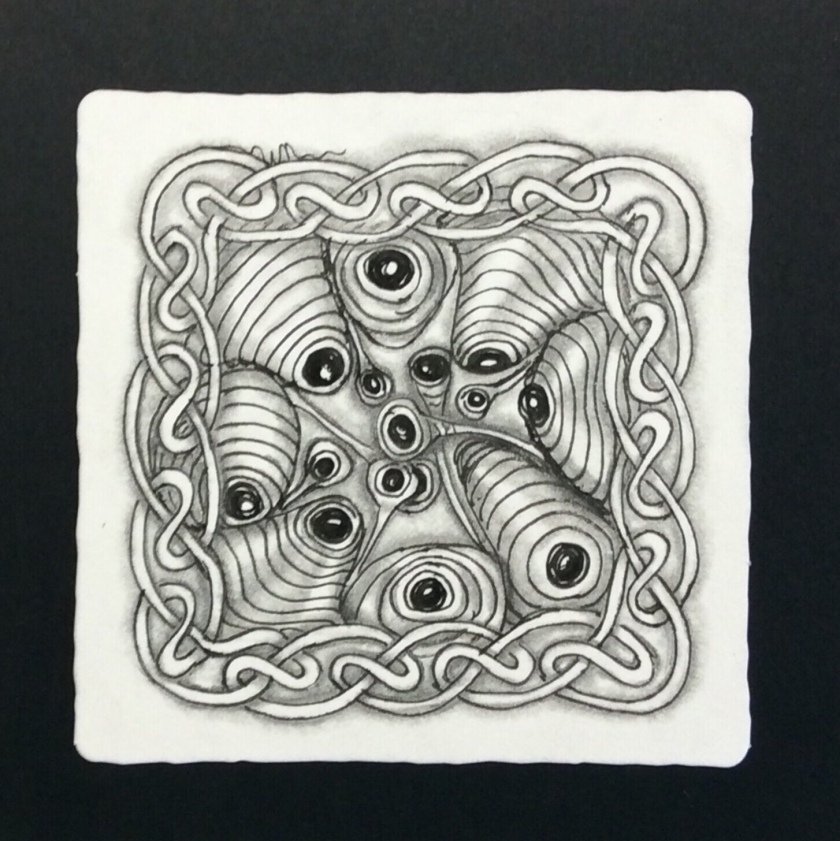
For a couple of weeks, I have been trying to chase down a lovely tangle by CZT Margaret Bremner called Skye. It reminds me of a Celtic knot in that it seems to be one continuous line.
[Update: A kind reader has found and sent the link to Margaret Bremner’s original step-out to Skye, which also features beautiful tiles tangled with Skye. Click here to access Margaret Bremner’s version, which is very similar to mine, but may be better/easier to use.]
Although there are several videos on YouTube (search term used: tangle pattern Skye), a Google search came up with no step-outs for Skye, regardless of search wording; and no step-out for Skye appears on TanglePatterns.com). And no matter how good the video, I kept messing up and really thought I needed the step-out to follow step by step without constantly having to pause and advance videos.

By the way, the YouTube video that I found most helpful can be found here. ( https://youtu.be/os0Js_gB0dw ) This tangle looks far more complex than it actually is, by the way. You will amaze yourself in the end.
Since searching yielded no step-out, I thought I would create my own, especially for when I need a reminder of how to tangle this pattern. Red lines indicate new additions.

This step-out is drawn in columns instead of the traditional tile-like steps. So, start with a column of backward Ss, leaving a little space between each one. Note that the top curve of the backward S is smaller than the lower curve. Next, the curve is auraed (haloed or replicated close by), starting outside the smaller curve and ending on the inside of the lower curve, in effect putting a larger curve at the top and a smaller one at the bottom.
Skye is a series of S curves, both backward and forward. They are “woven” using the Hollibaugh effect, the Zentangle term for drawing so it looks like something is going behind or under. A hint for this tangle is to draw the inside of the curved tubes first (right-hand line on the left side of the chain of backward Ss, left-hand line on the right side). This closes the backwards S tubes and helps guide the drawing of the lines.
Finally, connect the start of the tubed curve from nowhere under (behind) the bottom end of first backward S. At the bottom of the chain of backward Ss, and again starting under/behind, connect the top of the bottom backward S around the outside of the S, to the open tube left at the bottom of the fourth step-out column.
Some tanglers “get” this pattern right away. Others, like me, are distracted by openings to be Hollibaughed later, or some other reason; we have a more difficult time with this pattern. But once we get it, it becomes fun and really easy to tangle.


Skye can also be used as a string for tangling:

or (especially if you mess up like I did) become part of a background to be tangled over:

Hope my step-out of Margaret Bremner’s tangle Skye helps you enjoy this beautiful and flowing tangle. I am only starting to experiment with it. Hopefully I will soon be tangling variations and using it in more ways than I have illustrated here.
If you have any questions or suggestions regarding this step-out or Margaret Bremner’s pattern Skye, please leave a comment. I will do my best to address your comment. I am already working on a more detailed step-out that should need no verbal directions.
Until next time, Happy Tangling!
E.

Thank you so much for the step-out!!! practicing has begun ❤️
LikeLiked by 1 person
You’re welcome!
LikeLike
Here is the link to Margaret’s step-out: http://enthusiasticartist.blogspot.com/2016/05/skye-new-tangle.html
LikeLiked by 1 person
Thank you, purchased1994! I wonder why I couldn’t find it in any of my searches.
It’s always best to use the designer’s own step-out!
LikeLike
🙂
LikeLike
Thank Ellie for the stepout. I tried to go along with the video, but the stepout is much easier to follow 😍
LikeLiked by 1 person
Glad to hear that, Robin! I was worried there were not enough steps or directions. I have a more detailed step-out ready to photograph. It might be more helpful to new tanglers.
LikeLiked by 1 person